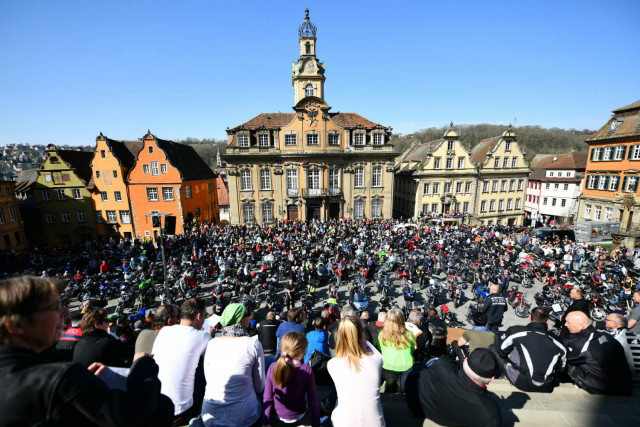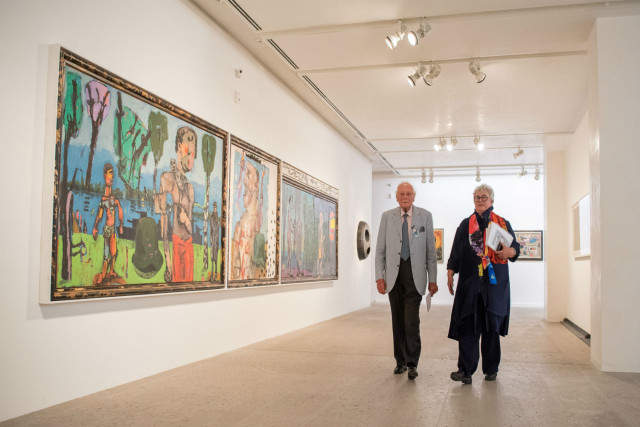Weekend Wanderlust: Hidden medieval charms in Schwäbisch Hall

This charming city in Baden-Württemberg remains off the trodden tourist path - despite an over a thousand-year old history as a hub of trade, and remaining largely unscathed over the centuries.
Those seeking the picture-postcard fachwerk (half-timbered) vision of Germany usually have to pay a price for the privilege - weaving through hordes of fellow tourists and being overcharged for food and drink.
If one knows there to look, however, there are some places that are relatively unsullied, and offer much the same charm, beauty and atmosphere as, say, Rothenburg ob der Tauber.
Schwäbisch Hall, located in the north-east of Baden-Württemberg, has been a centre of trade and commerce for well over a thousand years, yet a unique history has meant that a considerable amount of its heritage has managed not to be demolished or rebuilt - much to the delight of visitors.
Our story begins in the city of Schwäbisch Hall - just ‘Hall’ in those days - a town not too far from Stuttgart. In the late 15th century it was a free city of the Holy Roman Empire, a trading town known for two things - salt and coining. It was an affluent place. /2 pic.twitter.com/S3qDhSfZiJ
— Mike Stuchbery?? (@MikeStuchbery_) February 12, 2019
At first it was salt, then a minting industry, that brought ‘Hall’ (as it’s known locally) its fortune. The money pouring in from salt pools and coining was enough to ensure its status as a Free Imperial City for centuries.
A wall surrounding the Stadt
A large wall was built surrounding the town, with a number of towers looming over the local countryside. Much of the wall and towers are gone, but there are some sections you can still explore.
Most visitors to the town notice two distinct landmarks straight away - sitting atop the town like some sort of fortress is the ‘Zeughaus’, or Arsenal. Built in the 16th century to deter and defend outside attacks, this five-storey construction is now used as a theatre and venue for local arts.
The other landmark dominating the town is the Michaelskirche. A Gothic giant, it soars atop a steep set of stairs about the town’s main square. Beyond the massive, painted statue of the Archangel Michael that greets you at the door, the interior is a treasure house of medieval and renaissance religious art.

Locals and visitors sit outside in the Marktplatz for an annual outdoor church service for bikers. Photo: DPA
Among the many carved altars and ornate tombs, look for the tusk of a mammoth that was put on display. We can thank the reformer Johannes Brenz for the state of the church - even as others across the country were being stripped, he protected the treasures of his hometown church.
While you’re close to the Michaelskirche, grab a bite to eat, or something more substantial at the Cafe Am Markt. While the place may appear mostly devoted to sweet treats - not that there’s anything wrong with that - there’s a lunch menu packed with local Swabian specialities to keep you going.
Baroque, half-timbred homes
The town centre itself is a mixture of baroque, half-timber and 19th century buildings, with some areas more pristine and uniform in their look than others. On a sunny day, yes, it’s a perfect place to capture some shots for Instagram. In the main square, look for the pillar that was used to chain up lawbreakers, and while wandering through the town, check out the sculptures erected celebrating the town’s heritage - I’m quite fond of the giant coins half-buried in the earth, personally.
Down by the river Kocher, some bits of the city’s old walls, and a couple of covered bridges crossing the river can be found. They’re another great place to snap some shots, especially when the sun is shining onto the river.
If it’s more culture you’re looking for, the two outposts of the Würth Collection are well worth your time. Established by local tool manufacturer Reinhold Würth in the 1980s, the main gallery houses a permanent collection of art from the 17th to 21th centuries, in addition to rotating exhibitions.

Visitors to the Würth Collection in April 2018. Photo: DPA
A short distance away, a collection of 15 and 16th century masterpieces from Lucas Cranach and other German Old Masters, is housed in the medieval, gothic Johanniterkirche. This really is a sight to behold, and gives you some idea of the way Germans of the period viewed themselves and their faith.
If you’re planning on staying the night, may I recommend the Residenz am Weilertor - accommodation in one of the city’s remaining medieval towers, and only a few minutes walk from all the major sights. Additionally, it’s next to a really nice wine bar, Weinstube Weilertor, known for its selection of local wines and Swabian culinary mainstays.
As close as you can get to the medieval Germany of popular imagination, Schwäbisch Hall is most definitely one of our picks for a day-trip or longer.
Schwäbisch Hall is easily accessible via road and rail from Stuttgart, Nuremberg and Heilbronn - multiple rail and bus services depart daily from each.
EXPLORE:
-
Zeughaus/Rosenbühl 14, 74523 Schwabisch Hall
-
Michaelskirche/Am Markt 1, 74523 Schwabisch Hall
-
Cafe Am Markt/Am Markt 10, 74523 Schwabisch Hall
-
Würth Collection/Reinhold-Würth-Straße 15, 74523 Schwabisch Hall
-
Old Masters @ Johanniterkirche/Im Weiler 1, 74523 Schwabisch Hall
-
Residenz Im Weilertor/Im Weiler 18, 74523 Schwabisch Hall
Comments
See Also
Those seeking the picture-postcard fachwerk (half-timbered) vision of Germany usually have to pay a price for the privilege - weaving through hordes of fellow tourists and being overcharged for food and drink.
If one knows there to look, however, there are some places that are relatively unsullied, and offer much the same charm, beauty and atmosphere as, say, Rothenburg ob der Tauber.
Schwäbisch Hall, located in the north-east of Baden-Württemberg, has been a centre of trade and commerce for well over a thousand years, yet a unique history has meant that a considerable amount of its heritage has managed not to be demolished or rebuilt - much to the delight of visitors.
Our story begins in the city of Schwäbisch Hall - just ‘Hall’ in those days - a town not too far from Stuttgart. In the late 15th century it was a free city of the Holy Roman Empire, a trading town known for two things - salt and coining. It was an affluent place. /2 pic.twitter.com/S3qDhSfZiJ
— Mike Stuchbery?? (@MikeStuchbery_) February 12, 2019
At first it was salt, then a minting industry, that brought ‘Hall’ (as it’s known locally) its fortune. The money pouring in from salt pools and coining was enough to ensure its status as a Free Imperial City for centuries.
A wall surrounding the Stadt
A large wall was built surrounding the town, with a number of towers looming over the local countryside. Much of the wall and towers are gone, but there are some sections you can still explore.
Most visitors to the town notice two distinct landmarks straight away - sitting atop the town like some sort of fortress is the ‘Zeughaus’, or Arsenal. Built in the 16th century to deter and defend outside attacks, this five-storey construction is now used as a theatre and venue for local arts.
The other landmark dominating the town is the Michaelskirche. A Gothic giant, it soars atop a steep set of stairs about the town’s main square. Beyond the massive, painted statue of the Archangel Michael that greets you at the door, the interior is a treasure house of medieval and renaissance religious art.

Locals and visitors sit outside in the Marktplatz for an annual outdoor church service for bikers. Photo: DPA
Among the many carved altars and ornate tombs, look for the tusk of a mammoth that was put on display. We can thank the reformer Johannes Brenz for the state of the church - even as others across the country were being stripped, he protected the treasures of his hometown church.
While you’re close to the Michaelskirche, grab a bite to eat, or something more substantial at the Cafe Am Markt. While the place may appear mostly devoted to sweet treats - not that there’s anything wrong with that - there’s a lunch menu packed with local Swabian specialities to keep you going.
Baroque, half-timbred homes
The town centre itself is a mixture of baroque, half-timber and 19th century buildings, with some areas more pristine and uniform in their look than others. On a sunny day, yes, it’s a perfect place to capture some shots for Instagram. In the main square, look for the pillar that was used to chain up lawbreakers, and while wandering through the town, check out the sculptures erected celebrating the town’s heritage - I’m quite fond of the giant coins half-buried in the earth, personally.
Down by the river Kocher, some bits of the city’s old walls, and a couple of covered bridges crossing the river can be found. They’re another great place to snap some shots, especially when the sun is shining onto the river.
If it’s more culture you’re looking for, the two outposts of the Würth Collection are well worth your time. Established by local tool manufacturer Reinhold Würth in the 1980s, the main gallery houses a permanent collection of art from the 17th to 21th centuries, in addition to rotating exhibitions.

Visitors to the Würth Collection in April 2018. Photo: DPA
A short distance away, a collection of 15 and 16th century masterpieces from Lucas Cranach and other German Old Masters, is housed in the medieval, gothic Johanniterkirche. This really is a sight to behold, and gives you some idea of the way Germans of the period viewed themselves and their faith.
If you’re planning on staying the night, may I recommend the Residenz am Weilertor - accommodation in one of the city’s remaining medieval towers, and only a few minutes walk from all the major sights. Additionally, it’s next to a really nice wine bar, Weinstube Weilertor, known for its selection of local wines and Swabian culinary mainstays.
As close as you can get to the medieval Germany of popular imagination, Schwäbisch Hall is most definitely one of our picks for a day-trip or longer.
Schwäbisch Hall is easily accessible via road and rail from Stuttgart, Nuremberg and Heilbronn - multiple rail and bus services depart daily from each.
EXPLORE:
-
Zeughaus/Rosenbühl 14, 74523 Schwabisch Hall
-
Michaelskirche/Am Markt 1, 74523 Schwabisch Hall
-
Cafe Am Markt/Am Markt 10, 74523 Schwabisch Hall
-
Würth Collection/Reinhold-Würth-Straße 15, 74523 Schwabisch Hall
-
Old Masters @ Johanniterkirche/Im Weiler 1, 74523 Schwabisch Hall
-
Residenz Im Weilertor/Im Weiler 18, 74523 Schwabisch Hall
Join the conversation in our comments section below. Share your own views and experience and if you have a question or suggestion for our journalists then email us at [email protected].
Please keep comments civil, constructive and on topic – and make sure to read our terms of use before getting involved.
Please log in here to leave a comment.